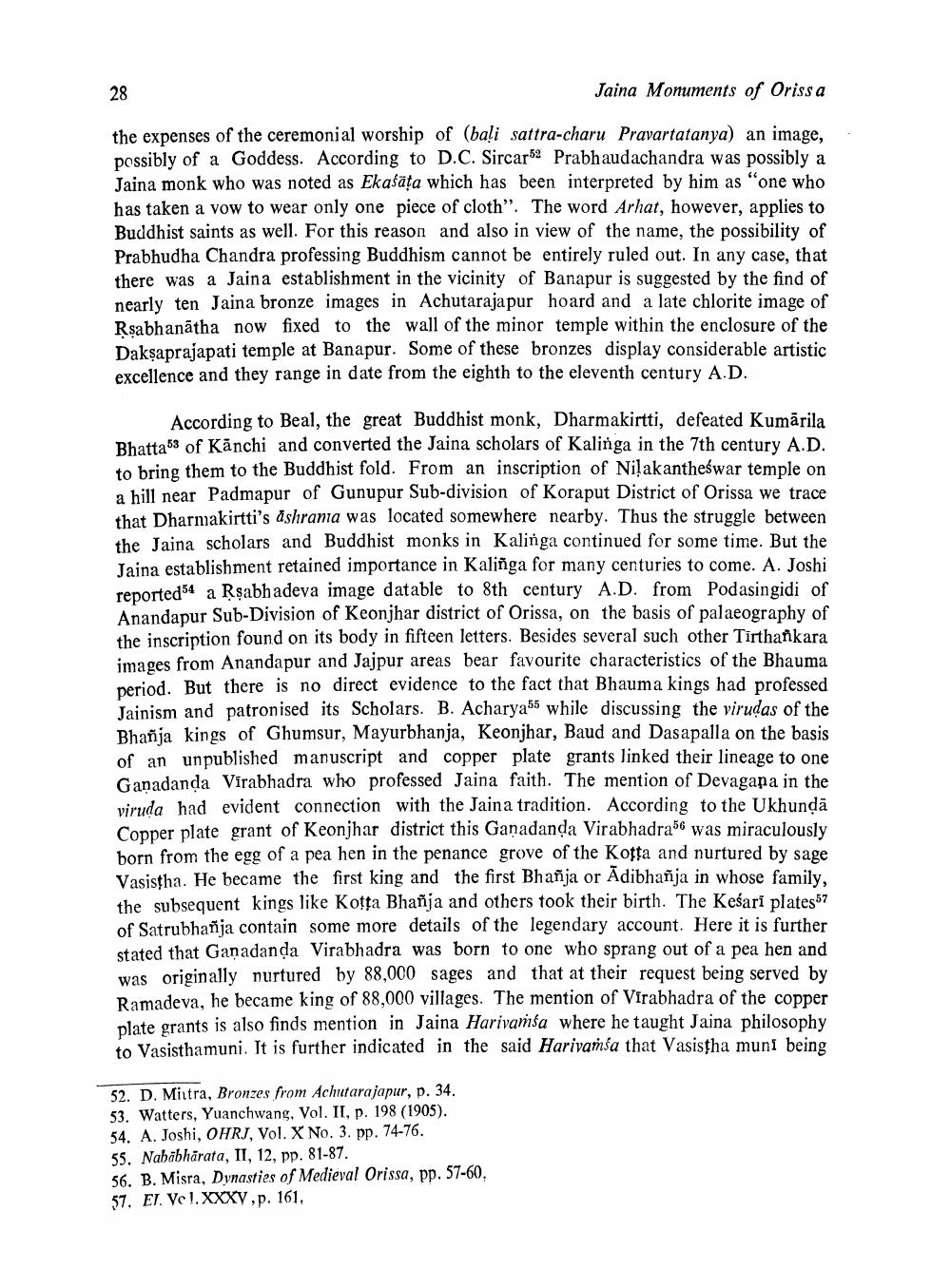________________
28
Jaina Monuments of Orissa
the expenses of the ceremonial worship of (bali sattra-charu Pravartatanya) an image, possibly of a Goddess. According to D.C. Sircar52 Prabhaudachandra was possibly a Jaina monk who was noted as Ekaśāta which has been interpreted by him as "one who has taken a vow to wear only one piece of cloth". The word Arhat, however, applies to Buddhist saints as well. For this reason and also in view of the name, the possibility of Prabhudha Chandra professing Buddhism cannot be entirely ruled out. In any case, that there was a Jain a establishment in the vicinity of Banapur is suggested by the find of nearly ten Jaina bronze images in Achutarajapur hoard and a late chlorite image of Rsabhanātha now fixed to the wall of the minor temple within the enclosure of the Dakşaprajapati temple at Banapur. Some of these bronzes display considerable artistic excellence and they range in date from the eighth to the eleventh century A.D.
According to Beal, the great Buddhist monk, Dharmakirtti, defeated Kumārila Bhatta53 of Kānchi and converted the Jaina scholars of Kalinga in the 7th century A.D. to bring them to the Buddhist fold. From an inscription of Nilakantheswar temple on a hill near Padmapur of Gunupur Sub-division of Koraput District of Orissa we trace that Dharmakirtti's ashrania was located somewhere nearby. Thus the struggle between the Jaina scholars and Buddhist monks in Kalinga continued for some time. But the Jaina establishment retained importance in Kaliñga for many centuries to come. A. Joshi reported 54 a Rşabhadeva image datable to 8th century A.D. from Podasingidi of Anandapur Sub-Division of Keonjhar district of Orissa, on the basis of palaeography of the inscription found on its body in fifteen letters. Besides several such other Tīrthankara images from Anandapur and Jajpur areas bear favourite characteristics of the Bhauma period. But there is no direct evidence to the fact that Bhauma kings had professed Jainism and patronised its Scholars. B. Acharya55 while discussing the virudas of the Bhañja kings of Ghumsur, Mayurbhanja, Keonjhar, Baud and Dasapalla on the basis of an unpublished manuscript and copper plate grants linked their lineage to one Ganadanda Virabhadra who professed Jaina faith. The mention of Devagana in the viruda had evident connection with the Jaina tradition. According to the Ukhundā Copper plate grant of Keonjhar district this Ganadanda Virabhadra was miraculously born from the egg of a pea hen in the penance grove of the Kofta and nurtured by sage Vasistha. He became the first king and the first Bhañja or Adibhanja in whose family, the subsequent kings like Kotta Bhañja and others took their birth. The Kesari plates 57 of Satrubhañja contain some more details of the legendary account. Here it is further stated that Ganadanda Virabhadra was born to one who sprang out of a pea hen and was originally nurtured by 88,000 sages and that at their request being served by Ramadeva, he became king of 88,000 villages. The mention of Virabhadra of the copper plate grants is also finds mention in Jaina Harivamsa where he taught Jaina philosophy to Vasisthamuni. It is further indicated in the said Harivañía that Vasistha muni being
52. D. Mitra, Bronzes from Achutarajapur, p. 34. 53. Watters, Yuanchwang. Vol. II, p. 198 (1905). 54. A. Joshi, OHRJ, Vol. X No. 3. pp. 74-76. 55. Nabābhārata, II, 12, pp. 81-87. 56. B. Misra, Dynasties of Medieval Orissa, pp. 57-60. 57. EI. V . XXXy,p. 161.




